Introduction
Measuring approximately 38,000m2, Federal square stands out as a masterpiece of architecture. This is a size equivalent to a city block. It lies on top of a fully operational railway and, in contrast to conventional public spaces, it is constituted of interlocked and cascaded spaces. It exits at from all of the city’s angles to produce multiple connections as well as vistas. There is a widely held perception that its design borrows a lot from the concept of a confederation which is all about bringing together (Pierluigi 2006, p. 258).
Interior Space
As Goffman (1959, p. 23) states, buildings always have a way of interacting with their interior. The Federal Square has an open interior and measures 16 by 16 meters. It has a gallery enclosed with glasses which shelter the plazas extension, in addition to acting as NGV’s forecourt as well as a forecourt to other business spaces. Its interior further makes use of multiple non-uniform structural frame shapes. The same is the case with NGV building. This lattice offers the much needed support to the glass panels. Also of interest are the distinct frame density, shades, as well as orientation views that subtly change to create in-built variability along the atrium’s length.
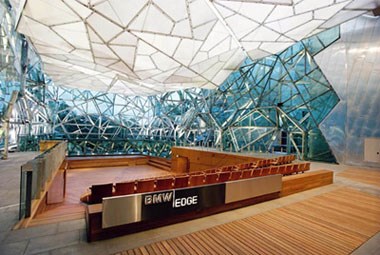
On the other hand, the roof is more pronounced at the Atrium and alters the space from its sensational winter garden look to something more of a greenhouse that is made of glass. However, the area, which could have easily passed off as a botanical glasshouse in the past, appears to be closer to a shaded street that digs deep into buildings’ entire mass/structure (Byrnes 2012, p. 14). Further, there is the sold roof placed on a rather choppy structure according it a unique look. Ultimately, it easily passes of for a mall or a foyer.
Its design extends beyond mere logo representations. The design almost certainly offers more than just a free façade idea but rather stretched beyond the décor (Coslovich 2009, p. 115). The entire design of the space is such that it not only matches its geographical location, but also the décor of Melbourne city. The space is further classified on basis of contextual references rebuff without losing its form and image. Further, it deservedly benefits from the current scenario, location at the city’s edge, infrastructural proximity, as well as topographic land-scape maps that help align two major buildings at the complex. The buildings include “The Ian Potter Centre: NGV Australia” and “Atrium (Brown-May 2003, p. 68).” However, there are also other compositions which offer the space the much needed strong impression and aura reminiscent of classical work of architecture.
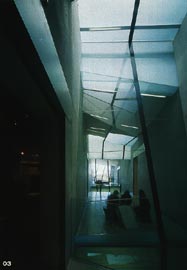
Further, note should be taken of the triangular geometry of the shards. This rather unique geometrical alignment regulates the structures as well as aesthetics of various components. The representation of multifarious lines in the building’s body presents multiple and confusing perceptions/views (Shmith 2014, p. 211). However, it could as well be depicted as representative of the composition adopted during construction process. To an extent, this element appears as architectural work’s cover, while to another extent, it can be viewed as claddings not attached to the architectural work’s outer cover (Byrnes 2012, p. 15).
NGV interior is characterized with a double filament galleries composition as expressed.
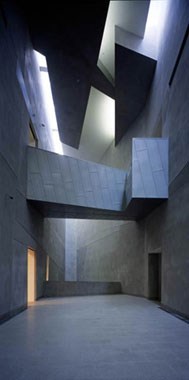
Atmosphere
The claddings in both the NGV building and the Federal Square allow for camouflage to the space’s enclosure, but leave room for aesthetic glamour associated. The thickened wall, on the other hand, lacks any significant purpose rather than only looking as a mask (Brown-May 2003, p. 71). The enclosures are made in such a way that the area retains its aesthetical appeal. The position of the openings largely depends on contingency of the interior, alongside the immediate space (Coslovich 2009, p. 114). Other than these, the polychromatic nature of the claddings facilitated by a mixture of materials used including sand-stone exteriors, alongside zinc and glass components (Byrnes 2012, p. 16). This is closely in line with topographical motion of various building parts.
The NGV building is a symbolical representation of culture in its polymorphous exterior. Additionally, it offers physical access through its several entrances. The buildings’ major collections are created in a controlled and chronological order and as such offer a platform through which visitors can also inscribe their individual experiences to the galleries’ collection by moving then view-lines to the galleries. In essence, visitors have to engage NGV’s collections.
The approach yields great display in its South Eastern facade, more particularly with respect to its plan. The sectional drawing cuts across the stairway to the south (Shmith 2014, p. 212). Further, the building’s intra-filaments are as intriguing as the entire space within which it lies. The structure is characterized with a kind of volumetric composition, whereby space is defined by both natural and artificial aspects. The extensive and unique tectonic strategy applied in NGV terminates at the Atrium (Shmith 2014, p. 212). Consequently, it falls under classification of architectural realization of the19th century architect’s dream with regard to applicability of steel and glass in areas other than aesthetics in design (Coslovich 2009, p. 113). Further, in the past, public space definition purely encompassed empty spaces representative of commercial or cultural centers.
Also worth mentioning is the Atrium. This is a remarkably excellent gallery structure made of steel and glass. The structure has an excellent indoor also doubling as exhibition stands, allows display of items, and also used for showcasing purposes. This space is, as a matter of fact, home to top galleries in Melbourne and so is NGV building. Other than enjoying constant flow of pedestrians, it has a hanging ceiling. Its central flow is further modified by two galleries, in each case, steel offering good rig locations. It also avails a means for directly accessing the renowned, “Deakin Edge theatre.” All the venues offer huge potential for hosting festivals, exhibitions and other great events. This puts it in a strategic position in terms of usability.
Differentiation
NGV Australia, just like the Federation Square, provides its statement in a discrete manner. Its faceted atrium canopy, outdoor plaza embrace, and/or enormous nature of exhibition hall, that is veiled in darkness, gives unique and discrete statements (Coslovich 2009, p. 114). The line with figure eight architectural across NGV building leads the journey conjuring what appears to be ghostly architectural heritage; sentimental aspirations to cultural insight as well as contemporary utopianism are suggested by elements that include gallery’s scale ascension (Brown-May 2003, p. 77).

The blend, glamour and master-piece have a lot to offer in terms of visual renderings. In deviation from grid, the federal square displays traits typical of contemporary society, thanks to the crystalline patterns visible in the exterior. There is also a distraction of lighting tracks configuration. Additionally, the design calls for temporary display walls placement, such that there is intrusion of architectural design into exhibition meaning (Shmith 2014, p. 213). On the other hand, NGV’s architecture provides curatorial/creative opportunities just like it does constraints.
The basic overlapping galleries’ combination allows a straightforward route across its outstanding layout. Alternatively, there are pathways through which one can opt to traverse the building. Traversing the building is easy, thanks to a range of accessibility options that converge at its central position (Brown-May 2003, p. 73). The section formed at the building’s cross-bar inter-section.
The main exhibition space has dual over-lapping filaments. In their midst, filaments have been formed. The spaces are within enclosures, show calmness, and are darker to the building’s northern area. This opens to the outer landscape which offers a view of Yarra facing the south. However, the internal filament space to the South has continuous glass walls that bridge the levels (Brown-May 2003, p. 74).
Total Design
The Deck
Below the square is a deck upon which it lays. The deck is extremely big and projected to be amongst the largest in the city. It is made of steel and concrete supports. In addition to this, there are spring coils whose functions are more about controlling vibrations than offering support. The deck also has rubber paddings. Its design also makes it suitable for sensitive uses such as radio station transmissions, TV stations, and cinemas (Byrnes 2012, p. 14). Thanks to its ability to seclude vibrations and noise, it is readily usable for such functions.
The Fractal Facade at Federation Square
Other than ability to support sensitive functions, Federal square’s and the NGV building offer plenty of space for galleries. They bring together surface in order to form an outstanding appearance that accounts for a large portion of its uniqueness. The surface geometries also help in maintaining unity irrespective of having different buildings within it. Its façade, rather distinctive, has an outstanding geometry made purely from triangular slabs (Brown-May 2003, p. 56). The slabs are combined into several pieces each to form bigger triangular with the process repeating itself upwards to produce the outstanding triangular pin-wheel grid. The grid is further a product of multiple materials, that is, sand-stone, glass pieces and zinc (Coslovich 2009, p. 114). As already mentioned, the segmental system combines five small triangular shaped slabs to create a bigger triangular slab panel, and so forth until the entire façade is ready (Byrnes 2012, p. 14). The formed slabs are then mounted to steel frames.

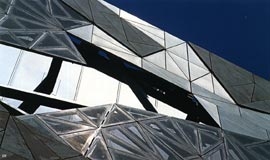
Federal square’s Edges and centers
Flinders Street marks the end of the square. This is more particularly to its northern side. There is also Seidlers’ Shell Building constituting the space’s edge, which marks a grid corner. It also forms part of the street’s wall and stretches along the Boulevard lane. The joining of the edges is such that they reinforce their point of linkage to the open panorama at St. Paul’s façade (Brown-May 2003, p. 67). Also included in its edges is the Lab architecture studio, a structure that contributes to fine labyrinthine lane dotting the street grid.
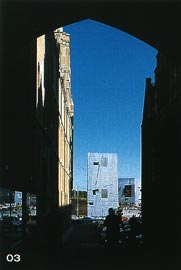
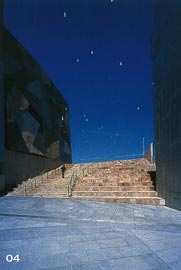
The section stretching through the main plaza as one originates from Swanston Street, strikes one with an artificial yet so natural-looking scene reminiscent of desert-like space. This may even pass as a true depiction of surreal geology. However, there is some form of pre-urban landscape in the region between the normal levels and the train’s lanes. This is more like the NGV building which incorporate a modern look that completely alters its environ.
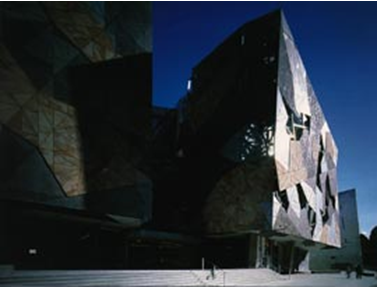
Research notes
In a single definition, despite the fact that the void is of extreme importance to Mies, the architectural input fills the lacking inspirational attractiveness expected of the structure and further offers a reasonable alternative to deal with the dull outlook (Coslovich 2009, p. 113). It should be noted that the Atrium has a lot to offer (Strizic 2014, p. 35). Its elegant and attractive structure stretches and twists, in addition to leaning on the gallery’s wall creating memories of the 19th century approaches. As a matter of fact, the Atrium can be said to sensationalize relationship of organic/mechanic to the traditional distinction between decor and structure. This is achieved effectively such that the structure itself looks more like a decor monument (Brown-May 2003, p. 72). The building confirms unification of tectonics and space and as such, endorses an intrinsic link between decor and structure.

Other than a unique range of spatial features, there is a disappointing abrupt boundary termination. Restoration of Batman Avenue has been done in asphalt, but still fails to front the street as desirable (Coslovich 2009, p. 112). At times there is stepping down into non-existent space. In some areas, the concept backs uncertain of a street’s existence.


Conclusion
In general, the Federal square can be termed as an imaginary urban life vision. In essence, it combines culture, recreation as well as commerce while at the same time maintaining Melbourne’s city glamour (Coslovich 2009, p. 115). The federal square, therefore, stands out as a common public space that brings together cultures, design, people as well as innovative works. It incorporates mixture of attractions which embody Victorian fine arts, acts of hospitality, vibrant events, and boldness, among others.
Similarly, NGV building stands out as symbolic and monumental buildings. Like the Federal Square, it espouses major architectural pillars that help it effectively merge with its surroundings to create a unique and serene environment.
References
Brown-May, A 2003, Federation Square, Hardie Grant Books, South Yarra, Vic.
Byrnes, M 2012, The Best and Worst of the World’s Central Plazas and Squares, The Atlantic Cites, vol. 14, no. 3, pp. 13-15.
Coslovich, G 2009, The Square’s vicious circle, The Age, vol. 23, no. 2, pp. 113 -117.
Goffman, E 1959, Presentation of self in everyday life, Doubleday, New York.
Pierluigi, S 2006, ‘The Spectacular Form of Interior Architecture Under the New Conditions of Urban Space’ in Fisher, F, Keeble T, Lara-Betancourt, P & Martin, B (eds), Performance Fashion And The Modern Interior, Berg, London, UK, pp. 257 – 269.
Shmith, M 2014, Raising the roof with a glass ceiling, The Age, vol. 15, no. 5, pp. 211-215.
Strizic, M 2014, A Journey in Photography, Travelling Exhibitions, vol. 3, no. 2, pp. 34-39.